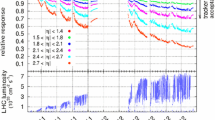Abstract
Purpose
Cesium iodide (CsI) crystals are widely used in high-energy physics for their scintillation properties that enable detection of charged and neutral particles via direct and indirect ionization and form the basis of electromagnetic calorimeters. However, knowledge of antineutron interactions with CsI is limited due to the difficulty of obtaining antineutron sources in sufficient intensity and wide energy range. As antineutron are abundantly produced by many physics process, it would be particularly useful to improve understanding of the interactions of antineutrons with CsI crystals.
Methods
We propose to use decay of \(J/\psi \rightarrow p\pi ^-\bar{n}\) at a \(J/\psi \) factory as a source of antineutrons and a CsI target added between the beam pipe and the detector to study such interactions. We use Monte Carlo simulation at the BESIII experiment as a proof of the concept. The simulation with varying thicknesses of CsI target is performed to validate the approach and optimize the target thickness.
Results and conclusions
Selecting charged particle tracks (p and \(\pi ^-\)) from the Monte Carlo sample, we obtain clean antineutron samples with well defined momentum and direction. The selection efficiency, momentum and angular resolutions, as well as the interaction probability between antineutron and the CsI target are estimated. As the CsI thickness is increased more antineutron-CsI interactions are obtained, however the quality of the \(p\pi ^-\) part selection is degraded. The Monte Carlo study yields an optimum thickness that balances these effects. This approach can be applied to similar experiments with other types of target materials such as liquid hydrogen/deuterium and other baryons such as \(\Lambda \) and \(\Xi \).








Similar content being viewed by others
References
R. L. Workman et al. (Particle Data Group), PTEP 2022, 083C01 (2022)
S.B. Athar et al., CLEO Collaboration. Phys. Rev. Lett. 100, 181802 (2008)
M. Ablikim et al., BESIII Collaboration. Phys. Rev. D 86, 052011 (2012)
M. Ablikim et al., BESIII Collaboration. Nat. Phys. 17(11), 1200–1204 (2021)
M. Ablikim et al. (BESIII Collaboration), Nucl. Instrum. Methods Phys. Res., Rect. A 614, 245 (2010)
R. A. Briere et al. (CLEO Collaboration), CLNS-01-1742
E. Kou et al. (Belle-II Collaboration), PTEP 2019, no.12, 123C01 (2019) [erratum: PTEP 2020, no.2, 029201 (2020)]
S. Agostinelli et al., GEANT4 Collaboration. Nucl. Instrum. Meth. A 506, 250 (2003)
L. Liu, X. Zhou, H. Peng, Nucl. Instrum. Meth. A 1033, 166672 (2022)
T. Armstrong et al., Brookhaven-Houston-Pennsylvania State-rice. Phys. Rev. D 36, 659–673 (1987)
M. Agnello et al., Nucl. Instrum. Meth. A 399, 11–26 (1997)
T. Bressani, A. Filippi, Phys. Rept. 383, 213–297 (2003)
C.Z. Yuan, M. Karliner, Phys. Rev. Lett. 127(1), 012003 (2021)
Q. Qin, L. Ma, J. Wang, and C. Zhang, Conf. Proc. C 100523, 2359 (2010), IPAC-2010-WEXMH01, http://accelconf.web.cern.ch/AccelConf/IPAC10/papers/wexmh01.pdf
D.M. Asner et al., Int. J. Mod. Phys. A 24, S1 (2009)
M. Ablikim et al. (BESIII Collaboration), Chin. Phys. C 44, no.4, 040001 (2020)
W. Li et al., Proc. Int. Conf. Comput. High Energy and Nucl. Phys. 225 (2006)
J. Zhang et al., Radiat. Detect. Technol. Methods 2, 20 (2018)
J. Wang et al., Chin. Phys. C 33, 870–879 (2009)
Acknowledgements
Thank Weimin Song and Liang Liu for their help with the software. This work is supported in part by National Key Research and Development Program of China under Contract No. 2020YFA0406300, National Natural Science Foundation of China (NSFC) under contract No. 12275297, and NSFC Basic Science Center Program for “Joint Research on High Energy Frontier Particle Physics” (Grant No. 12188102).
Author information
Authors and Affiliations
Corresponding author
Ethics declarations
Conflict of interest
The authors declare that they have no conflict of interest.
Rights and permissions
Springer Nature or its licensor (e.g. a society or other partner) holds exclusive rights to this article under a publishing agreement with the author(s) or other rightsholder(s); author self-archiving of the accepted manuscript version of this article is solely governed by the terms of such publishing agreement and applicable law.
About this article
Cite this article
Yuan, S., Wang, L. & Li, W. An approach to study interactions of antineutrons with CsI at a \(J/\psi \) factory. Radiat Detect Technol Methods (2024). https://doi.org/10.1007/s41605-024-00454-z
Received:
Revised:
Accepted:
Published:
DOI: https://doi.org/10.1007/s41605-024-00454-z




